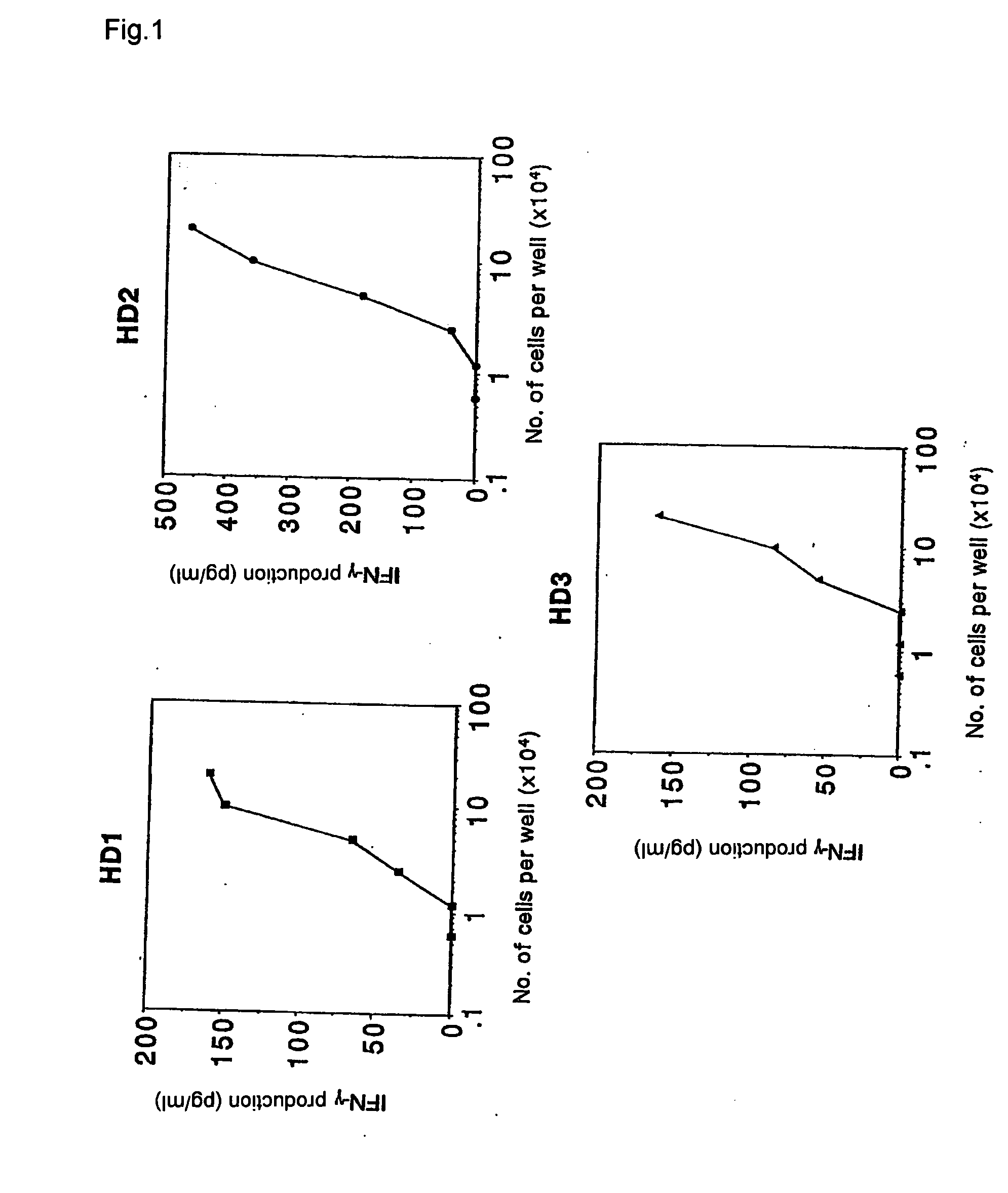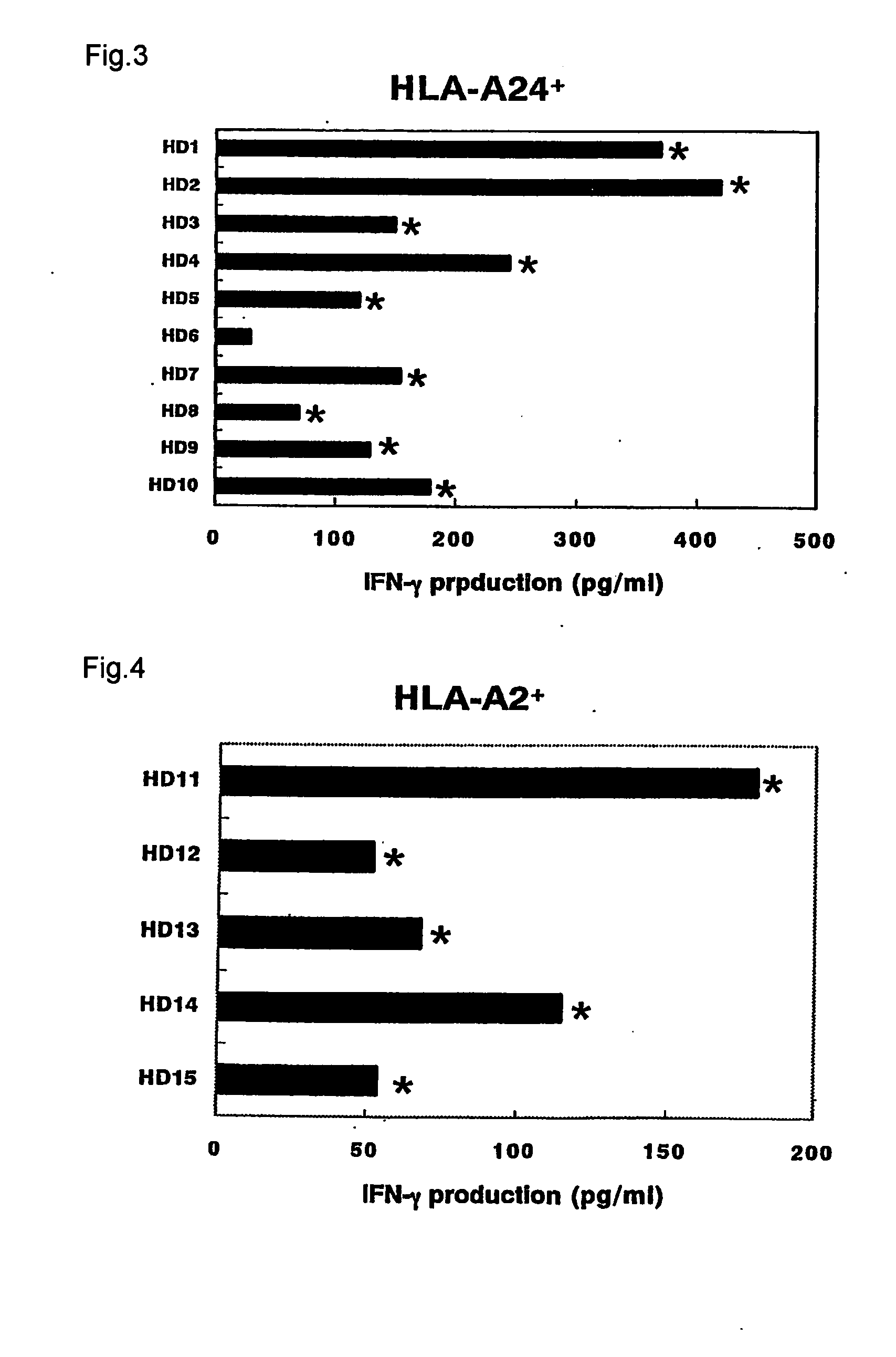Method of detecting cellular immunity and application thereof to drugs
a technology of cellular immunity and antigens, applied in the field of immunotherapy, can solve the problems of large number, difficult to determine whether a particular spot is positive or not, complex process, etc., and achieve the effect of increasing the expression of cell surface antigens and expressing stably
- Summary
- Abstract
- Description
- Claims
- Application Information
AI Technical Summary
Benefits of technology
Problems solved by technology
Method used
Image
Examples
example 1
(Detection of Antigen Peptide-specific T Cells Using an EB Virus-derived Antigen Peptide)
[0090] Most healthy people retain EB virus (EBV)-specific T cell precursors relatively frequently from a past EB virus infection. Therefore, we tried to detect the EB virus-specific T cell from peripheral blood mononuclear cells (PBMCs) of healthy donors with a history of EB virus infection with positive blood anti-EB virus antibody.
[0091] The PBMCs were isolated from the peripheral blood of HLA-A24 positive healthy people by the specific gravity centrifugal method using Ficoll Conray solution. The PBMCs were cultured in a medium wherein to 45% RPMI-1640, 45% AIM-V (GIBCO BRL Inc.), and 10% FCS, 100 IU / ml of interleukin-2 (IL-2), 0.1 mM MEM nonessential amino acid solution (GIBCO BRL Inc., hereinafter called “NEAA”) were added (hereinafter called lymphocyte medium). PBMCs were suspended in the lymphocyte medium at 5×105 cells / ml and inoculated in a 96-well plate having U-shaped bottoms at 200...
example 2
(Analysis of the Frequency of EB Virus Derived Antigen Peptide-Specific T cells)
[0093] (1) According to the procedure in example 1, the increase in frequency of EB virus derived HLA-A24 restricted antigen peptide-specific T cells was confirmed by limiting dilution analysis.
[0094] The PBMCs were prepared from the same healthy donor as Example 1 by the same procedure, and the following measurement of frequency of antigen specific T cells was performed with or without stimulating a portion of the PBMCs using an antigen peptide. Another portion of PBMCs were added to a 96-well plate having wells with a U-shaped bottom at a concentration of 1×105 cells / well in a method similar to that in Example 1. These were cultured while being stimulated using EB virus derived HLA-A24 restricted antigen peptides four times in total every three days. The cultures were subsequently measured for the frequency of the antigen-specific T cells as described below.
[0095] The measurement of the frequency o...
example 3
(Peptide Stimulated CTLs and Their Specificity)
[0099] To isolate PBMCs, blood samples collected from healthy donors and patients were heparinized and PBMCs were obtained by density gradient electrophoresis. All donors of the blood samples were serologically HIV negative and HTLV-1 negative.
[0100] Various densities of PBMCs were cultured by adding them to 96-well microplates having wells with a U-shaped or flat bottom with 200 μl of medium containing 10 μM of an antigen peptide. The medium used consisted of a composition of 45% RPMI-1640, 45% AIM-V, 10% FCS, 100 IU / ml of IL-2, and 0.1 μM of NEAA.
[0101] The antigen peptides used were the following: [0102] EB virus derived peptide comprising HLA-A24 binding motif (sequence of amino acids: TYGPVFMCL) (SEQ ID No: 31); [0103] EB virus derived peptide comprising HLA-A2 binding motif (sequence of amino acids: GICTLVAML) (SEQ ID No: 32); [0104] Influenza virus (Flu) derived peptide comprising HLA-A24 binding motif (sequence of amino acid...
PUM
| Property | Measurement | Unit |
|---|---|---|
| time period | aaaaa | aaaaa |
| time period | aaaaa | aaaaa |
| focal depth | aaaaa | aaaaa |
Abstract
Description
Claims
Application Information
 Login to View More
Login to View More - R&D
- Intellectual Property
- Life Sciences
- Materials
- Tech Scout
- Unparalleled Data Quality
- Higher Quality Content
- 60% Fewer Hallucinations
Browse by: Latest US Patents, China's latest patents, Technical Efficacy Thesaurus, Application Domain, Technology Topic, Popular Technical Reports.
© 2025 PatSnap. All rights reserved.Legal|Privacy policy|Modern Slavery Act Transparency Statement|Sitemap|About US| Contact US: help@patsnap.com



